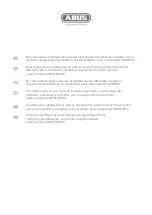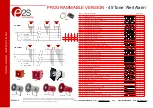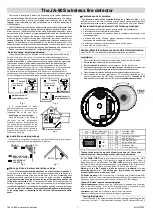
Moving a Saved Waypoint
1
Select
Info
>
User Data
>
Waypoints
.
2
Select a waypoint.
3
Select
Review
>
Edit
>
Position
.
4
Indicate a new location for the waypoint:
• To move the waypoint using coordinates, select
Enter Coordinates
, enter the new coordinates, and
select
Done
or
Cancel
.
• To move the waypoint while using the chart, select
Use Chart
, select a new location on the chart, and
select
Move Waypoint
.
• To move the waypoint using the vessel's current
position, select
Use Current Position
.
• To move the waypoint using a range (distance)
and bearing, select
Enter Range/Bearing
, enter the
information, and select
Done
.
Browsing for and Navigating to a Saved Waypoint
WARNING
All route and navigation lines displayed on the chartplotter
are only intended to provide general route guidance
or to identify proper channels, and are not intended
to be precisely followed. Always defer to the navaids
and conditions on the water when navigating to avoid
groundings or hazards that could result in vessel damage,
personal injury, or death.
The Auto Guidance feature is based on electronic chart
information. That data does not ensure obstacle and
bottom clearance. Carefully compare the course to all
visual sightings, and avoid any land, shallow water, or
other obstacles that may be in your path.
When using Go To, a direct course and a corrected
course may pass over land or shallow water. Use visual
sightings, and steer to avoid land, shallow water, and
other dangerous objects.
NOTE:
Auto Guidance is available with premium charts, in
some areas.
Before you can navigate to a waypoint, you must create a
waypoint.
1
Select
Info
>
User Data
>
Waypoints
.
2
Select a waypoint.
3
Select
Navigate To
.
4
Select an option:
• To navigate directly to the location, select
Go To
.
• To create a route to the location, including turns,
select
Route To
.
• To use Auto Guidance, select
Auto Guidance
.
5
Review the course indicated by the magenta line.
NOTE:
When using Auto Guidance, a gray segment
within any part of the magenta line indicates that Auto
Guidance cannot calculate part of the Auto Guidance
line. This is due to the settings for minimum safe water
depth and minimum safe obstacle height.
6
Follow the magenta line, steering to avoid land,
shallow water, and other obstacles.
Deleting a Waypoint or an MOB
1
Select
Info
>
User Data
>
Waypoints
.
2
Select a waypoint or an MOB.
3
Select
Review
>
Delete
.
Deleting All Waypoints
Select
Info
>
User Data
>
Delete User Data
>
Waypoints
>
All
.
Routes
A route is a path from one location to one or more
destinations.
Creating and Navigating a Route From Your Present
Location
You can create and immediately navigate a route on the
Navigation chart or the Fishing chart. This method does
not save the route.
1
From the Navigation chart or Fishing chart, select a
destination.
2
Select
Navigate To
>
Route To
.
3
Select the location of the last turn before the
destination.
4
Select
Add Turn
.
5
If necessary, repeat to add turns, working backward
from the destination to the present location of your
vessel.
The last turn you add should be the first turn you make,
starting from your present location. It should be the
turn closest to your vessel.
6
Select
Done
.
7
Review the course indicated by the magenta line.
8
Follow the magenta line, steering to avoid land,
shallow water, and other obstacles.
Creating and Saving a Route
You can add up to 250 turns to one route.
1
Select
Info
>
User Data
>
Routes
>
New
>
Route
Using Chart
.
2
Select the starting location of the route.
The starting point can be your present location or
another location.
3
Select
Add Turn
.
4
Select the location of the next turn on the chart.
5
Select
Add Turn
.
6
If necessary, repeat steps 4 and 5 to add more turns.
7
Select
Done
.
28
Navigation with a Chartplotter
















































